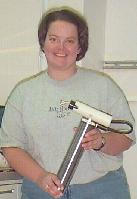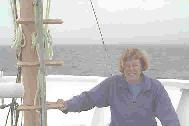| |
Teacher
Logbook:
Wednesday, July 26, 2000
Mary Beth's
Observations
Today is rainy
and cold outside so I have to chosen to focus on a piece of equipment
in the ship's lab. The MAPR, a Miniature Autonomous Plume Recorder, is
a piece of equipment used to collect hydrothermal plume data. The MAPR
is built using a titanium tube. Titanium is used to withstand the demands
of deep ocean research, very cold temperatures and very high pressures.
The MAPR is deployed on mooring lines often remaining in the ocean for
up to a year. The MAPR records data every thirty minutes until it is brought
back up to the surface. What does a MAPR record? The instrument has several
different functions. Each MAPR is equipped with a temperature sensor,
a pressure sensor and a nephelometer. A nephelometer measures particle
density, an indicator of plume existence. After looking at the picture
you should be able to identify various part of the MAPR. The white tube
on top is the housing for the nephelometer. The pressure sensor is housed
in a small, plastic tube just under the nephelometer. The temperature
sensor is actually housed inside the titanium tube. The titanium automatically
adjusts to the temperature of the surrounding water.
On this cruise, the MAPR's
were recovered when we recovered moorings the first couple days of the
cruise. They are scheduled to return to the ocean before we return to
Seattle. Before they can be deployed, the data is downloaded, the batteries
are changed and the titanium housing are cleaned. Stay tuned for pictures
of the MAPRs being deployed back into the ocean!
Carol's
Observations
Today I feel how big, powerful and moveable the ocean can be compared
to land. We have a light rain and the wind has picked up. The ship is
moving with the swells and I have to work to keep my balance. The chairs
have suction cups on the legs to keep them from rolling across the floor.
All of the drawers lock automatically. Some of the counters have special
rubber mats to keep things in place. It was great doing the interview
with Ron. Sometimes you can figure out what is going on by watching. There
are other times you have to ask someone. Everyone on the ship has been
very helpful answering our questions. Join me tomorrow to find out what
new discoveries I make at sea.
Carol
|
|

Mary Beth with the MAPR.

Carol hanging on at the bow during some rough seas.
|
|

